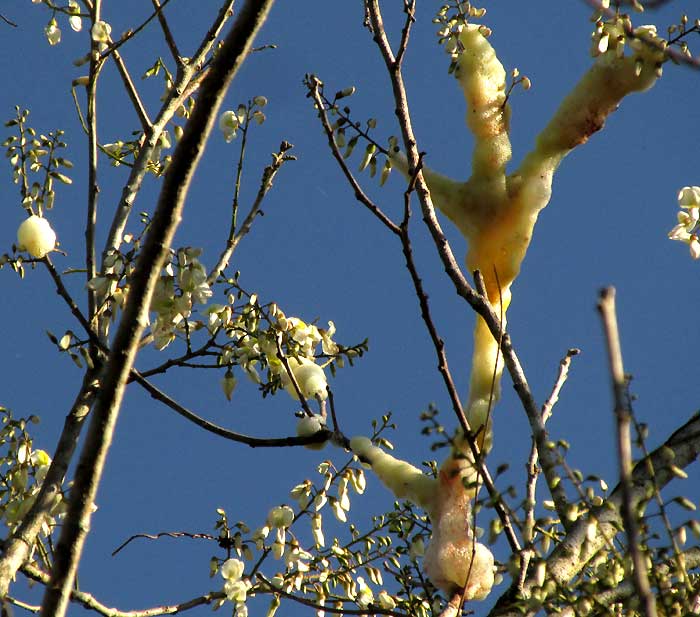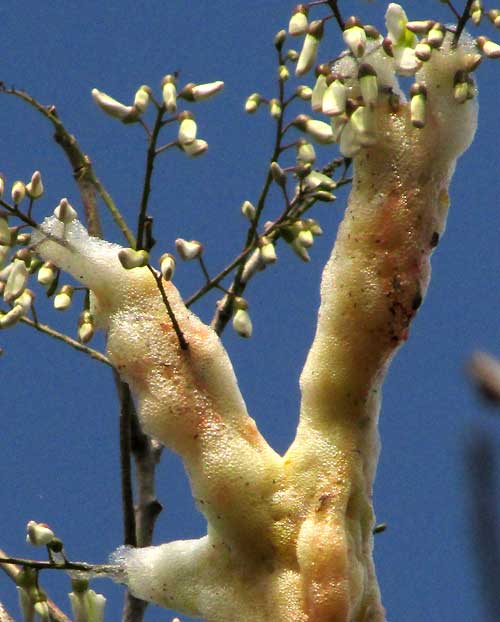Excerpts from Jim Conrad's
Naturalist Newsletter
from the February 8, 2019 Newsletter issued from Rancho Regensis north of Valladolid, Yucatán, MÉXICO;
elevation ~40m (~130 ft), N~20.876°, W~88.170°
FUNGAL FOAM ON FLOWERING "SPRING" TREE

Beside the trail from the hut to the tool shed, the dry-season-leafless limbs of a certain smallish tree were resplendent with white, bean-family-type flowers. Though common throughout most of Mexico, the tree has no good English name. In much of Mexico it's called Primavera, which means "Spring," and if we have a spring here, this week may have been it, so it's not a bad name. You can see the spectacular tree and read about it at www.backyardnature.net/yucatan/gliricid.htm
One morning this week as I passed down the trail admiring the tree in dazzling, blue-sky sunlight, I noticed that about twenty feet up some of the top branches appeared to be covered with white foam, as you can see at the top of this page.
Atop the tree, In an area about the size of a refrigerator, maybe five or so foam gobs could be seen, all small except the cross-shaped one occupying the picture's right side. No other part of the tree bore such foam bodies, and none of the dozen or so other trees of this species I checked had any. A telephoto shot showing this tree's foam closer up is shown below:

The closest thing I've seen to this was back in 2009 when my friend Karen and I found a conspicuous body of orange slime stuck to the side of a wild grapevine. I had no idea what it was and it took years before I could put together a story about it all, and ;post pictures of it, which you can still see on our "Orange Slime" page at www.backyardnature.net/n/x/orgslime.htm
That orange slime turned out to be produced by an ascomycete fungus (mildews, molds, morel mushrooms) called Fusicolla merismoides. The fungus produces slimy orange sheets covering the stem, with spore-producing bodies embedded within and on the slime. By the way, keep in mind that "slime molds" are something else entirely, not even considered to be fungi.
But, the foam on our "Spring" tree isn't really slime. Is it caused by another of the seven listed species of Fusicolla, besides the one making orange slime on grapevines in Mississippi?
On our Orange Slime page I pass along the newest information about Fusicolla merismoides. At that time it was just being realized that instead of being a distinct species, genetic analysis was finding that what was called Fusicolla merismoides actually consisted of a large complex of many phylogenetic species.
I really don't know what to say about the foam on our "Spring" tree. Both the Orange Slime on the grapevine in Mississippi and the foam on our "Spring" tree occurred exactly when sap was rising in the host plants. My guess is that a fungus or fungus-like organism, or maybe a varied population of different kinds of windblown microscopic organisms found a source of carbohydrate in our tree's sap, maybe dripping from a broken twig, and set up residence in the sugary sap, maybe fermenting it. Fermentation could cause bubbles of carbon dioxide to form, creating foam.
The foam on our tree lasted at least for two days, but on the hot, dry, sunny, windy afternoon of the second day after I'd noticed it, the foam quickly disappeared, leaving not a trace, and has not returned.
So, as in 2009, I'm filing this information and the pictures on the Internet, hoping that someday someone will come along explaining it all to me, and then I'll pass the info on to others.